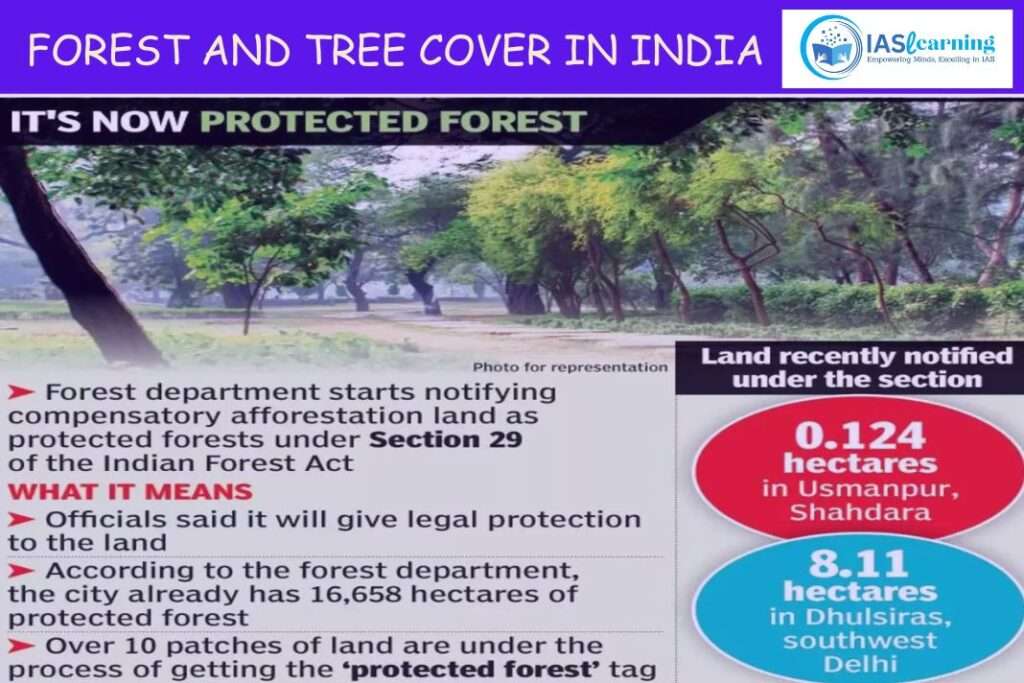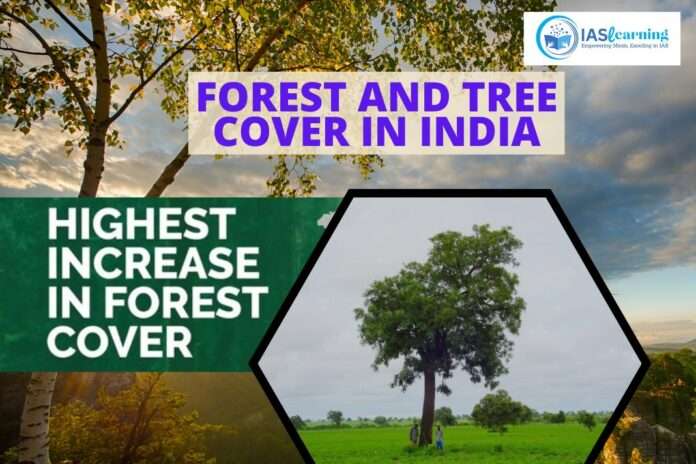Introduction to Forest and Tree cover
In the diverse tapestry of India, there exists an often overlooked but immensely vital element – its forest and tree cover. Beyond their aesthetic beauty, these ecosystems play a pivotal role in maintaining the ecological balance, supporting biodiversity, and sustaining the livelihoods of millions of people. In this comprehensive article, we will delve into the fascinating world of forest and tree cover in India, exploring its significance, current state, challenges, and the way forward.
Understanding Forest and Tree Cover
Forests and tree cover encompass all vegetation, whether natural or man-made, that includes trees and canopies. However, it’s crucial to distinguish between ‘forest cover’ and ‘tree cover.’ Forest cover implies dense, natural forests, while tree cover includes trees planted in urban and rural areas, along roads, railways, and more. Both types contribute to India’s ecological wealth.

Significance of Forests
1. Biodiversity Hotspots
India’s forests are a treasure trove of biodiversity, housing a wide array of flora and fauna. From the royal Bengal tiger to the majestic Indian elephant, these ecosystems provide a habitat for countless species. Protecting forests is paramount in preserving this rich biodiversity.
2. Carbon Sequestration
Forests are the planet’s lungs. They absorb carbon dioxide from the atmosphere and release oxygen, mitigating climate change. In a world grappling with environmental issues, India’s forests are crucial carbon sinks.
3. Water Security
Forests play an essential role in maintaining water cycles. They prevent soil erosion, regulate water flow in rivers, and ensure a steady supply of freshwater for agriculture and consumption.
4. Cultural and Traditional Significance
Forests are deeply intertwined with India’s culture and traditions. They have spiritual significance and are home to many indigenous communities, preserving their unique way of life.

The Current State of Forests in India
Despite their undeniable importance, India’s forests face numerous challenges:
1. Deforestation
Rapid urbanization, industrialization, and agricultural expansion have led to extensive deforestation. This threatens not only the ecological balance but also the livelihoods of forest-dependent communities.
2. Illegal Logging
Illegal logging remains a significant issue, depleting valuable forest resources and disrupting ecosystems. Tougher regulations and enforcement are needed to combat this menace.
3. Encroachments
Forest lands are often encroached upon for various purposes, further reducing forest cover. Effective land management strategies are necessary to address this problem.
4. Forest Degradation
Many forests in India are degraded due to unsustainable practices. Reforestation and afforestation initiatives are essential to restoring these ecosystems.
Forest and Tree Cover has a profound impact on all aspects of life, from the environment to human well-being:
- Biodiversity: Forests and tree cover provide critical habitats for countless species of plants and animals. They serve as biodiversity hotspots, supporting a wide range of life forms, many of which are endemic and endangered.
- Climate Regulation: Trees absorb carbon dioxide during photosynthesis, helping to mitigate the greenhouse effect and combat climate change. They also release oxygen into the atmosphere, essential for human and animal respiration.
- Air and Water Quality: Trees act as natural filters, removing pollutants from the air and groundwater. Their presence helps maintain clean and healthy ecosystems, improving the quality of air and water resources for human consumption.
- Soil Health: Forests and tree cover protect against soil erosion and degradation. Their roots stabilize soil, preventing it from washing away during heavy rains, and their leaf litter enriches the soil with nutrients.
- Economic Benefits: Forests are a source of livelihood for millions of people worldwide, providing resources such as timber, fruits, nuts, and medicinal plants. They also support the tourism industry, generating income for local communities.
- Flood Control: Tree cover can reduce the risk of flooding by slowing down rainwater runoff and allowing it to infiltrate into the ground. This natural flood control can protect communities and their infrastructure.
- Recreation and Mental Health: Forests and green spaces offer opportunities for recreation and relaxation, promoting mental and physical well-being. They provide a respite from the stresses of urban life.
- Cultural and Spiritual Significance: Forests hold cultural and spiritual value for many societies. They are often considered sacred and are integral to cultural practices, traditions, and ceremonies.
- Medicine and Pharmaceuticals: Many pharmaceuticals have their origins in plants found in forests. These natural resources are invaluable for medical research and the development of new medicines.
- Global Stabilization: Forests play a crucial role in stabilizing global ecosystems. They help regulate rainfall patterns, maintain temperature balance, and support the overall stability of the Earth’s environment.
Government Initiatives and Conservation Efforts
The Indian government has recognized the importance of preserving forests and tree cover:
1. Project Tiger
Launched in 1973, Project Tiger aims to protect the Bengal tiger and its habitat. It has been successful in increasing tiger populations and conserving their ecosystems.
2. Green India Mission
This ambitious program focuses on increasing forest and tree cover, restoring degraded ecosystems, and enhancing biodiversity.
3. Joint Forest Management
Involving local communities in forest management has proven effective in many regions, leading to better conservation outcomes.

Conclusion
India’s forest and tree cover are not mere statistics but essential components of its natural and cultural heritage. It is our collective responsibility to protect and rejuvenate these ecosystems. By addressing deforestation, illegal logging, and encroachments while promoting reforestation and sustainable practices, we can ensure that future generations inherit a greener, more biodiverse India. Let us remember that the fate of our forests ultimately determines the fate of our planet.

